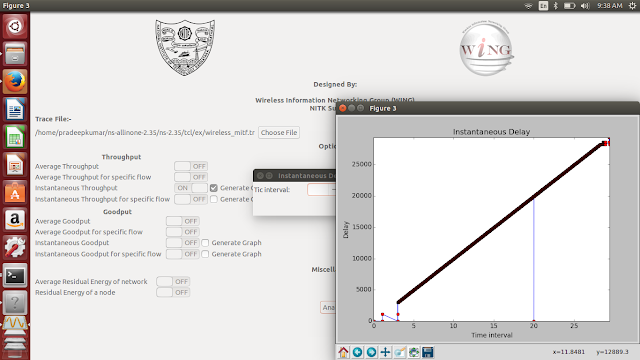There is a new tool that is developed by WING of NIT Surathkal. This tool analyze most of the aspects like
Download this tool from github https://github.com/WiNG-NITK/APP-Tool/archive/master.zip
Unzip it and give the following commands one by one
$prompt] sudo apt-get udpate
$prompt] sudo apt-get install python-matplotlib
$prompt] cd APP-Tool-master/
$prompt] python GUI_Main.py
Here are some of the screenshots
To open the App-tool-master
The following is to plot the throughput
This is for the throughput values to be plotted
The following for plotting the delay
The source codes with awk files are given inside the folder Final/. if anyone needs the awk for processing without this front end, you can use that too.
To run awk files
$prompt] awk -f Avg_Del.awk /full/path/to/your/tracefile.tr
or
$prompt] gawk -f Avg_Del.awk /full/path/to/your/tracefile.tr
This will print the average delay (See the following screenshot)
T S Pradeep Kumar
- throughput
- goodput
- residual energy of a node
- delay
- packet delivery ratio
- etc
Download this tool from github https://github.com/WiNG-NITK/APP-Tool/archive/master.zip
Unzip it and give the following commands one by one
$prompt] sudo apt-get udpate
$prompt] sudo apt-get install python-matplotlib
$prompt] cd APP-Tool-master/
$prompt] python GUI_Main.py
Here are some of the screenshots
To open the App-tool-master
 |
| App-tool-master |
 |
| App-tool-master |
 |
| App-tool-master |
 |
| App-tool-master |
 |
| App-tool-master |
To run awk files
$prompt] awk -f Avg_Del.awk /full/path/to/your/tracefile.tr
or
$prompt] gawk -f Avg_Del.awk /full/path/to/your/tracefile.tr
This will print the average delay (See the following screenshot)
 |
| awk code for throughput and delay |
T S Pradeep Kumar
I have an error while run the application App-Tool-master
ReplyDeleteTraceback (most recent call last):
File "GUI_Main.py", line 4, in
from gi.repository import Gtk
ImportError: No module named gi.repository
How to solve?
I fixed it on my ubuntu 16.04 system by doing the following
Deletesudo apt install python-gobject
sudo apt install python-dbus
I have getting an error while run the application App-Tool-Master
ReplyDeleteTraceback (most recent call last):
File "GUI_Main.py", line 4, in
from gi.repository import Gtk
ImportError: No module named gi.repository
Please anyone help me.
I fixed it on my ubuntu 16.04 system by doing the following
Deletesudo apt install python-gobject
sudo apt install python-dbus
I am getting an error while running the application App-Tool-Master on Cent OS Linux
ReplyDeleteTraceback (most recent call last):
File "GUI_Main.py", line 4, in
from gi.repository import Gtk
ImportError: No module named gi.repository
Kindly help me.
Dear sir,
ReplyDeletei am using ubuntu 20
when i use this command - sudo apt-get install python-matplotlib
i got below given error,
The following packages have unmet dependencies:
python-matplotlib : Depends: python-cycler but it is not going to be installed
E: Unable to correct problems, you have held broken packages.
please help to me
Since now, python is deprecated whereever python comes replace it to python3 and try... For example
Deletepython3-matplotlib
Dear sir,
ReplyDeletei am using ubuntu 20
when i use this command - sudo apt-get install python-matplotlib
i got below given error,
The following packages have unmet dependencies:
python-matplotlib : Depends: python-cycler but it is not going to be installed
E: Unable to correct problems, you have held broken packages.
so i am used sudo apt-get install python3-matplotlib
but after execution of this command - python3 GUI_Main.py
APP tool window is open. but, windows is very wide. screen size is not is not able to minimize. so i am not able to use this tool. please help me
Dear sir,
ReplyDeletei am using ubuntu 22.04
when i use this command - sudo apt-get install python3-matplotlib
but after execution of this command - python3 GUI_Main.py
i got below given error,
rani@HP-PC:~/APP-Tool-master$ python3 GUI_Main.py
/home/rani/APP-Tool-master/GUI_Main.py:4: PyGIWarning: Gtk was imported without specifying a version first. Use gi.require_version('Gtk', '4.0') before import to ensure that the right version gets loaded.
from gi.repository import Gtk
Traceback (most recent call last):
File "/home/rani/APP-Tool-master/GUI_Main.py", line 1089, in
win = Main_window()
File "/home/rani/APP-Tool-master/GUI_Main.py", line 209, in __init__
self.set_border_width(10)
AttributeError: 'Main_window' object has no attribute 'set_border_width'
Kindly help me.